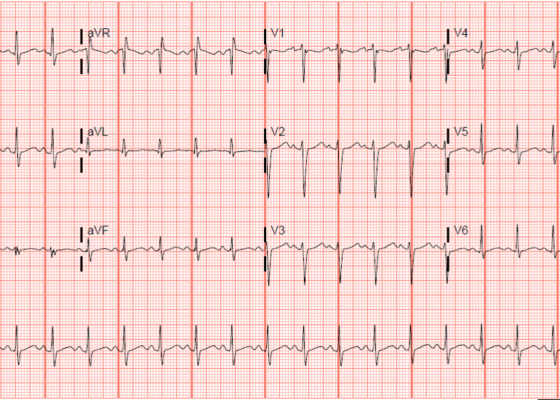Toxicology
Electrocardiogram Abnormalities Following Diphenhydramine Ingestion: A Case Report
DOI: https://doi.org/10.21980/J85H1PThe blue arrow points to one of the terminal R waves in aVR, and the green arrow points to one of the large S waves in lead I, indicating right axis deviation. These findings are pathognomonic for sodium channel blockade. Due to the specific ECG findings and knowledge of diphenhydramine overdose, it was evident that these ECG findings were due to a cardiac sodium channel blockade. Sodium channels are essential within myocardial tissue to ensure the rapid upstroke of cardiac action potential, as well as rapid impulse conduction throughout cardiac tissue. Therefore, sodium channel blockers tend to exhibit significant dysrhythmic properties due to severe conduction disturbances.2 The blockage of the cardiac sodium channels appears as terminal R waves in aVR as well as terminal S waves in lead I due to delaying, and possibly blocking, the electrical conduction pathway of the heart. The orange arrows show resolution of terminal R wave in aVR and terminal S wave in lead I, after administration of sodium bicarbonate.
Methemoglobinemia
DOI: https://doi.org/10.21980/J8PH1BAt the end of this simulation case, participants should be able to: 1) recognize shortness of breath, cyanosis and respiratory distress, and the difference between all of them based on the clinical presentation 2) identify the underlying cause of the condition by conducting a thorough history and physical 3) know how to identify and treat methemoglobinemia by ordering necessary labs and interventions and understand the pathophysiology leading to methemoglobinemia 4) recognize patient’s response to treatment and continue to reassess.
Mushroom for Improvement Case Report: The Importance of Involving Mycologists
DOI: https://doi.org/10.21980/J8ZW7WThe mushroom displayed here is large and lacks any gills. Small puffball mushrooms can resemble young immature button top Amanita type mushrooms. Opening the Amanita mushroom should reveal apparent gills and quickly differentiate the two- -the puffball mushroom should have a white interior without gills.
Cyanide Poisoning
DOI: https://doi.org/10.21980/J80W76After the completion of this simulation, participants will have learned how to: 1) identify clues of smoke inhalation based on a physical examination; 2) identify smoke inhalation-induced airway compromise and perform definitive management; 3) create a differential diagnosis for victims of fire cyanide poisoning, carbon monoxide, and carbon dioxide; 4) appropriately treat cyanide poisoning; 5) demonstrate the importance of preemptively treating for cyanide poisoning; 6) perform an initial physical examination and identify physical marks suggesting the patient is a fire and smoke inhalation victim; and 7) familiarize themselves with the Cyanokit and treatment with hydroxocobalamin.
Management of Poisoned Patients: Implementing a Blended Toxicology Curriculum for Emergency Medicine Residents
DOI: https://doi.org/10.21980/J8C937The goal of this curriculum is to introduce EM residents to core toxicology concepts and to reinforce toxicology principles through a multimodal approach that leads to increased confidence in the management of poisoned patients on shift.
Infant Botulism
DOI: https://doi.org/10.21980/J8X35WAfter this simulation learners should be able to: 1) develop a differential diagnosis for the hypotonic infant, 2) recognize signs and symptoms of infant botulism, 3) recognize respiratory failure and secure the airway with appropriate rapid sequence intubation (RSI) medications, 4) initiate definitive treatment of infant botulism by mobilizing resources to obtain antitoxin, 5) continue supportive management and admit the patient to the pediatric intensive care unit (PICU), 6) understand the pathophysiology and epidemiology of infant botulism, 7) develop communication and leadership skills when evaluating and managing critically ill infants.
Let’s Escape Didactics: Virtual Escape Room as a Didactic Modality in Residency
DOI: https://doi.org/10.21980/J8CH2XBy the end of the activity, learners should be able to: 1) identify the hazardous chemicals associated with house fires; 2) classify burn injury according to depth, extent and severity based on established standards; 3) recall the actions to take in response to fire emergencies (R.A.C.E. and P.A.S.S. acronyms); 4) recall key laboratory features of cyanide and carbon monoxide poisonings; 5) identify appropriate management strategies for smoke inhalation injuries; 6) recite the treatment for cyanide and carbon monoxide poisonings; 7) describe the management of the burn injuries; 8) communicate and collaborate as a team to arrive at solutions of problems; 9) display task-switching and leadership skills during exercise; and 10) evaluate virtual escape room experience.
Botulism
DOI: https://doi.org/10.21980/J8FD0RBy the end of this simulation learners will be able to: 1) develop a differential for descending paralysis and recognize the signs and symptoms of botulism; 2) understand the importance of consulting public health authorities to obtain botulinum antitoxin in a timely fashion; 3) recognize that botulism will progress during the time period antitoxin is obtained. Early indications of respiratory compromise are expected to worsen during this time window.
Secondary learning objectives include: 4) employ advanced evaluation for neurogenic respiratory failure such as physical examination, negative inspiratory force (NIF), forced vital capacity (FVC), and partial pressure of carbon dioxide (pCO2), 5) discuss and review the pathophysiology of botulism, 6) discuss the epidemiology of botulism.
Approach to the Poisoned Patient
DOI: https://doi.org/10.21980/J8264SBy the end of the lecture, learners should be able to: 1) initiate the evaluation of a poisoned patient, 2) identify key interventions to support airway, breathing, and circulation, 3) identify the three components of risk assessment in the poisoned patient, 4) list the four options for gastric decontamination, and 5) select standard diagnostic labs and tests commonly used in evaluating poisoned patients.
Case Report: Antifreeze Ingestion and Urine Fluorescence
DOI: https://doi.org/10.21980/J8G05TThe patient’s urine sample (right) was compared to a control (left) using a Wood’s lamp. It revealed light green fluorescence under ultraviolet light, which increased suspicion for ethylene glycol poisoning from antifreeze ingestion.



